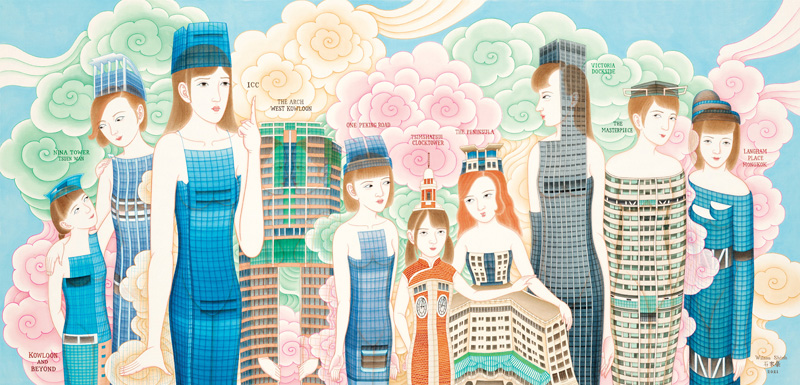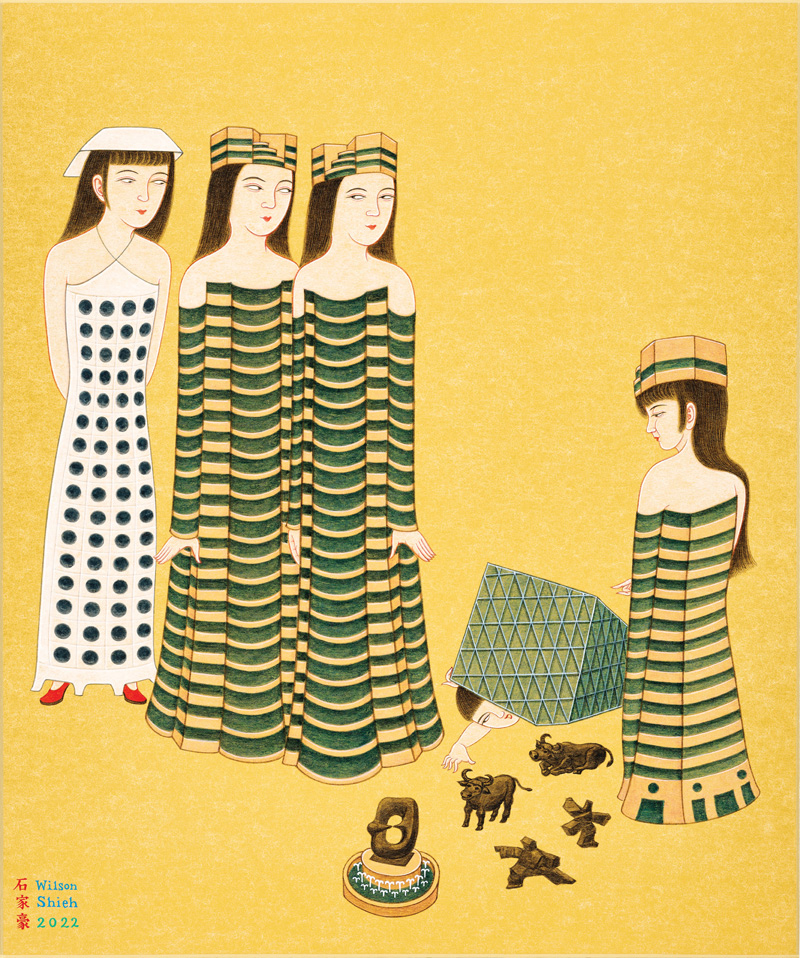石 家 豪
Wilson Shieh (lives and works in Hong Kong) studied fine art at the Chinese University of Hong Kong (CUHK), where he received his BA and MFA in 1994 and 2001 respectively. Best known for his architecture-inspired figures, he specialises in the Chinese gongbi painting technique.
Shieh has participated in numerous group exhibitions in Hong Kong, Oxford, Taichung, San Diego and Brisbane, including the Third Asia-Pacific Triennial of Contemporary Art (QAGOMA, Brisbane, 1999). He won the painting category at the Philippe Charriol Foundation Art Competition (1997) and received the Prize of Excellence at the Hong Kong Art Biennial (2003). His works have been collected by the Hong Kong Museum of Art, the M+ Museum of Visual Culture, the Ashmolean Museum at Oxford University, and the Asian Art Museum in San Francisco.
石家豪,香港居住及工作,從香港中文大學藝術系取得其學士(1994年)及藝術碩士(2001年)學位。他從事工筆畫創作,並以建築人物系列為人所認知。
歷年來於香港、台中、牛津、聖地牙哥及布里斯本等地參與多項展覽,包括1999年澳洲布里斯本的「第三屆亞太當代藝術三年展」等。石氏獲「夏利豪基金會藝術比賽1997」繪畫組冠軍,及「香港藝術雙年展2003」優秀獎,其作品入藏香港藝術館、西九M+視覺文化博物館、牛津大學阿什莫林博物館及三藩市亞洲藝術博物館。
Artist’s Statement
Thirty years ago, I attended a Chinese figure painting class in the Chinese University of Hong Kong’s Department of Fine Arts. When I first learned about gongbi (fine-brush) painting, I found out what Chinese painting looked like before the rise of shanshui (landscape) and huaniao (bird-and-flower) painting. The figure painting genre contains a rich historical tradition and an array of specialised aesthetic techniques. I worked to learn and practice figure painting in the hopes that I would develop gongbi figure techniques in contemporary Hong Kong.
Traditional figure painting was categorised according to the identities of the persons represented, such as court ladies, scholars, religious figures, emperors, generals, and ministers. Their position or status was clearly signalled by their clothing or adornment. When I developed my contemporary series, I focused on the identities and costumes of the figures, transforming them into the subject of the paintings.
The works exhibited here include the Architecture series that I started more than a decade ago. I transformed Hong Kong’s most famous modern buildings into clothing; this has since become my best-known work.
The other pair is the male and female versions of East, South, West, North. Although those four words stand for the four points of the compass, the pairing of south and north implies disparities in climate and lifestyle and the pairing of east and west signifies difference, and possibly even opposition, along national, ethnic, and cultural lines. In the composition, the figures representing east, south, west, and north all wear black clothing. I want to show that everyone in the world has a lot in common. The only difference is the clothing that covers our bodies; beyond that, our lives are actually very similar.
藝術家自述
我於三十年前在中大藝術系的中國人物畫課堂,首次學習工筆畫法,才知道中國畫在山水、花鳥題材興起前的面貌。人物畫科蘊藏豐富的歷史傳統及專門的美學技藝,因此我努力學習鍛煉,希望把工筆人物技藝在當代香港好好發揮展示。
傳統人物畫以人的身份分類,例如仕女、文人、仙佛、帝王、將相等,不同的地位職份以服飾裝扮來區別。所以我發展的當代人物系列,都是把身份及服裝的設計放大成為主題。
今次展出作品包括我十多年前開發的建築人物系列,把香港著名的現代現築,剪裁成為人物衣裝,成為我最受認知的標記作品。
另外一對有男版女版的《東西南北》,東南西北雖然是地理上的四個方向,但當中「南北」意味着氣候及生活習俗的差異,「東西」更可能是國族與文化的分別甚至是對峙。構圖時我把代表東南西北的四人靠緊,以墨色的衣服統一色感,意味大家在世界上相處其實非常接近,所謂差別只是披在身上衣服款式的細節不同,除此之外大家的存在都很密切。



